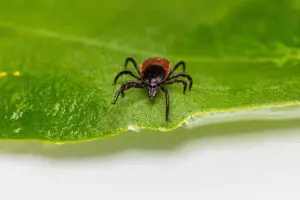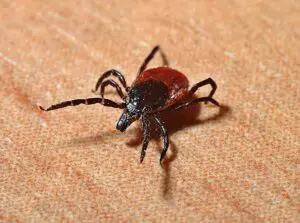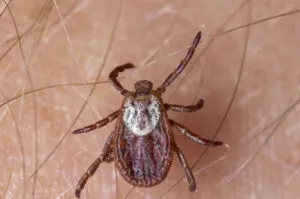
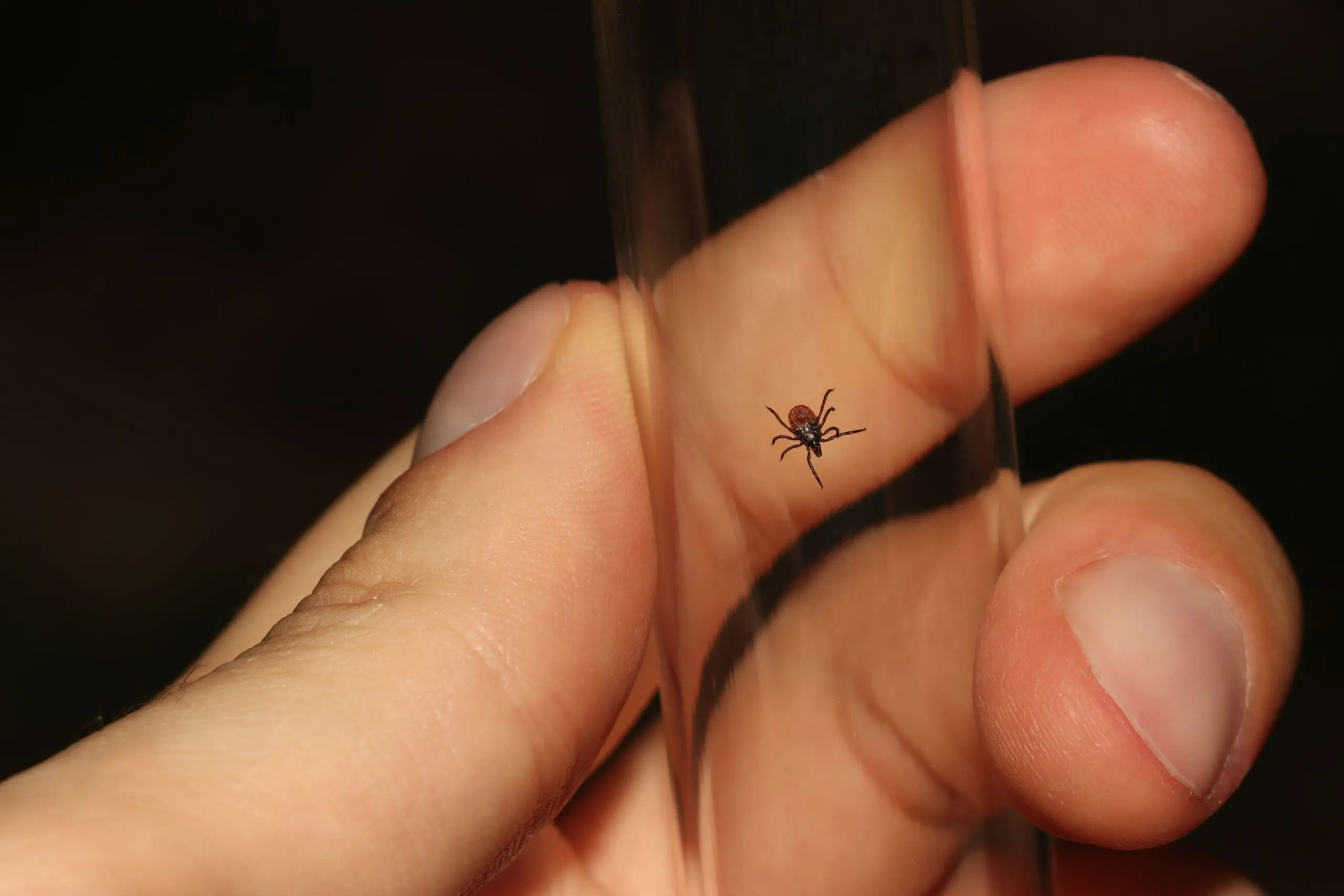
Interested in learning more about ticks? Well, you can become an expert. With 30 years of expertise behind us, here is all you need to know about these tiny pests.
Have a specific question? Jump to the answer:
Tick Basics
- What is a tick?
- What do ticks look like?
- What attracts ticks and where can I find them?
- Why are ticks dangerous for pets?
- Why are ticks dangerous for humans?
Tick Borne Diseases
- What is Lyme Disease?
- Do I have Lyme Disease?
- What is Tularemia?
- Do I have Tularemia?
- What is Ehrlichiosis?
- Do I have Ehrlichiosis?
Tick Borne Disease Statistics
- Which US states have the highest rate of tick-borne diseases?
- Which US states are most paranoid about tick-borne diseases?
- Tick borne diseases in Florida
- Tick borne diseases in New Jersey
Tick Bite and Infestation Prevention
- Why do I have a tick problem?
- What’s the best way to prevent a tick infestation?
- How to spot ticks
- How to spot a tick bite on your pet
- How to spot a tick bite on humans
- How do I get rid of ticks?
Tick Basics
What is a tick?
Ticks are parasitic arachnids that form part of the mite superorder Parasitiformes. The tiny creatures have a big presence as they are external parasites and live by feeding on the blood of mammals, birds and sometimes even amphibians and reptiles. There are 850 different tick species across the globe, and over 90 of these species can be found in the United States.
What do ticks look like?
You better have super vision when trying to spot a tick! Just kidding, these little parasites aren’t too small for the naked eye. Before feeding, ticks appear as small, wingless bugs with 8 legs and flat bodies that are shaped like teardrops. But once they latch onto a host, their bodies swell up and become much larger. A feeding tick looks like an engorged, oval-shaped bean stuck to skin and depending on its species, it can be black, brown, reddish-brown, gray, or yellow in color.
What attracts ticks?
Ticks are attracted to moist, warm environments and are most active in the early spring. They prefer to hide in shady areas, tall grass and shrubs and live near the ground in a variety of habitats, from small bushes to fallen leaves.
Similar to mosquitoes and fleas, ticks are also attracted to carbon dioxide that is exhaled by a potential host. They are also drawn to body heat and the lactic acid that comes from sweating. Ticks are usually repelled by the scent of lemon, orange, cinnamon, lavender, peppermint, and rose geranium so they avoid latching onto hosts that smell like these items.
Why are ticks dangerous for pets?
As ticks are intracellular parasites that suck blood from their hosts, they are also able to carry and transmit dangerous bacteria - and ticks are very attracted to our 4 legged friends. Ticks are very attracted to dogs in particular and can infect dogs with diseases like Lyme disease and ehrlichiosis. Both Lyme disease and ehrlichiosis can be fatal for dogs, so it's vital to detect ticks on your pets before it's too late.
Tick bites on dogs and cats can also be difficult to detect if you are not looking for them - so it’s important to always take a closer look at your pet's fur and to always keep an eye on any change in behavior. The symptoms of a tick bite in your furry family member may be different not only depending on the type of tick, but also on the type of dog or cat. Regardless, most of the time, your pet is going to be able to feel the itch of the bite, and you’ll be able to tell that there's one there.
Ticks are usually big enough to spot. So simply run your hands over your pet's body to check for any bumps or lumps surrounded by red and inflamed skin. A tick will feel like a small bump on your pet’s skin and they tend to attach themselves to areas around a pet’s head, neck, ear and feet. Brushing also helps to remove them from your pets fur.
Why are ticks dangerous for humans?
Tick bites in humans are oftentimes harmless however, they can cause allergic reactions and certain ticks are able to pass diseases on to humans when they feed. These diseases can be dangerous and sometimes life-threatening if not treated quickly. The diseases that a human can get from a tick bite include Lyme disease, Tularemia and Ehrlichiosis.
If a tick is carrying a disease such as Lyme (borrelia burgdorferi), babesia or anaplasmosis, it does not always transmit the disease through a bite. Ticks have to be fully engorged and embedded following their feeding to be able to transmit these diseases and the timing is usually 24 - 36 hours after attachment to the host.
However, the Centres for Disease Control and Prevention (CDC) has reported an increase in cases of tick-borne diseases in humans over the past decade and this is likely a result of an increase in diagnosing and reporting as well as an increase in the prevalence of disease.
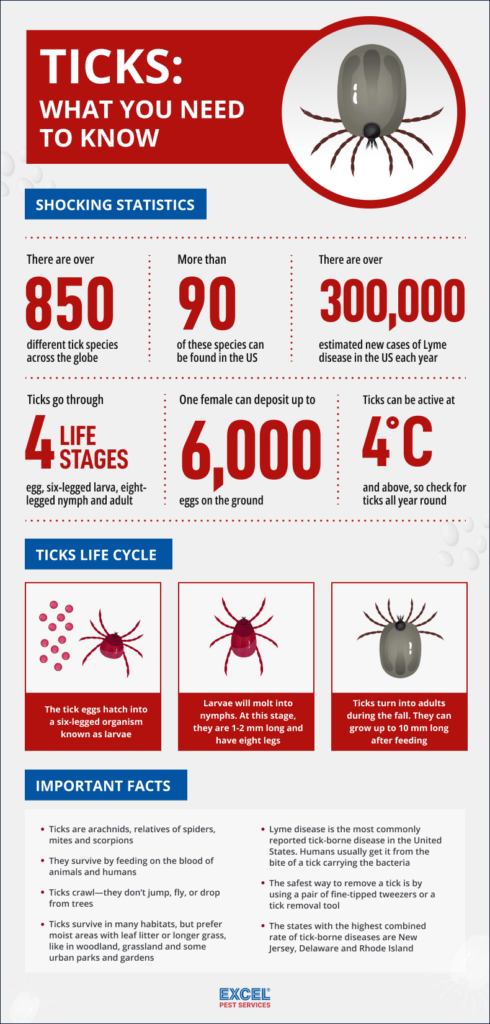
Tick Borne Diseases
What is Lyme Disease?
Lyme disease is the most common vector-borne disease (vectors are mosquitoes, ticks, and fleas that spread pathogens) in the United States. In recent years, approximately 20,000–30,000 confirmed cases of Lyme disease per year have been reported to the Centers for Disease Control and Prevention. The disease is caused by the bacterium Borrelia burgdorferi and rarely, Borrelia mayonii. Lyme disease is transmitted to humans through the bite of infected blacklegged ticks. Some of the most typical lyme disease symptoms include fever, headache, fatigue, and a skin rash referred to as erythema migrans.
If Lyme Disease is left untreated, the infection can spread to the heart, joints, and even the nervous system. It is diagnosed based on a variety of symptoms, physical findings , and of course, the possibility of exposure to infected ticks. Lab testing is the most accurate way to diagnose the illness. Most cases can be treated successfully with a few weeks of antibiotics.
Do I have Lyme Disease?
If you have walked through a woodland area, been near tall grass or found yourself near shrubs and trees, you may have been exposed to ticks. If you have noticed a small bump on your skin that has developed into a larger rash or you develop a rash anywhere else after noticing a small pump, possibly a rash with a bull's-eye pattern, it may indicate Lyme disease. This kind of rash usually appears within 3 to 14 days of the bite. Typical symptoms of Lyme disease also include fever, headache and fatigue. fatigue.
However, if you are worried that you may have Lyme Disease, get yourself to a doctor and get off Google. Your doctor will test your blood for any antibodies that are trying to fight the bacteria in your blood. One of these blood tests is called the ELISA test, and you'll often have a second test called the Western blot test to confirm you have Lyme disease. In order to treat Lyme disease, you may be put on antibiotics for up to a month.
What is Tularemia?
Ulceroglandular tularemia is borne from tick bites. If a person contracts tularemia from a tick bite, a skin ulcer will appear at the site where the bacteria entered the body. The ulcer is also accompanied by swelling of lymph glands, usually the glands located in the armpit or groin. In the US, ticks that transmit tularemia to humans include the dog tick, the wood tick, and the lone star tick. Deer flies have also been known to transmit tularemia in the western United States.
Do I have Tularemia?
If you notice the formation of an ulcer in an area where you have been bitten by a tick, or after being in an environment common for ticks, and experience a fever, then get yourself to the doctor. Remember, Google is not your doctor.
What is Ehrlichiosis?
Ehrlichiosis is an illness you can get through a tick bite. The illness is caused by the bacteria Ehrlichia and symptoms include a fever, muscle aches and headache. Based on studies, only around 30% of people (usually children) will get a rash from the illness.
Do I have Ehrlichiosis?
Ehrlichiosis is primarily spread through the bite of infected ticks and most notably, the lone star tick (Amblyomma americanum) and the blacklegged tick (Ixodes scapularis). If you live in a state common for the lone star and the blacklegged tick such as Florida or New Jersey, and have been bitten by a tick recently, it’s important you see a doctor if you experience fever, chills, headache, muscle aches, and sometimes upset stomach. Ehrlichiosis can cause serious complications if not treated quickly with antibiotics so make sure to get yourself to a professional.
US Tick Borne Disease Statistics
Which US states have the highest rate of tick-borne diseases?*
Based on research, although tick borne diseases are rare, they need to be taken seriously across the United States. But which states should be most concerned about these tiny parasites? We analyzed the most recent state-level data and google searches for tick-borne diseases in order to find out!
Lyme disease has the highest number of cases across the US, with 457.9 in 2020, while 349.79 cases of Ehrlichiosis were reported in that same year, and just 150 cases of Tularemia were diagnosed in 2019.
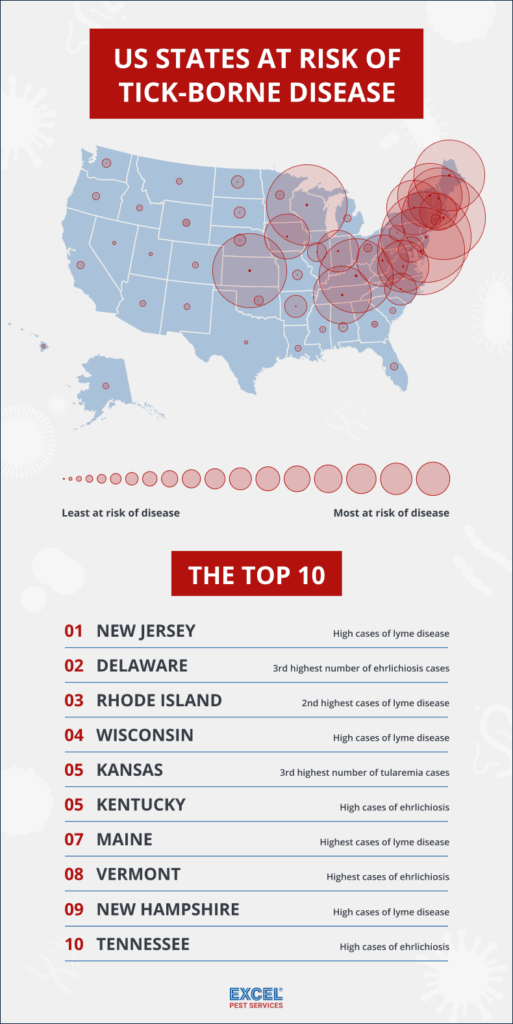
Rhode Island is the state with the worst combined rates of tick-borne diseases, coming in with the second highest cases of Ehrlichiosis at 42.48 per 100 000 persons in 2020 and second for cases of Lyme Disease per 100 000 persons in 2020, at an astounding 79.4. Rhode Island had 0 reported cases of Tularemia in 2019. However, even with 0 cases of Tularemia, the state is still at the highest risk for tick-borne illnesses.
Maine comes in as 2nd with the worst combined rates of tick-borne diseases. With an astounding 83.5 cases of Lyme Disease per 100 000 persons in 2020 - making it the state with the most cases of Lyme Disease in 2020. Maine comes in at 12 for the state with the most cases of Ehrlichiosis, with 9.67 reported cases in 2020.
Delaware takes 3rd place with 36 cases of Lyme Disease in 2020, 1 case of Tularemia in 2019 and 42.10 cases of Ehrlichiosis in 2020. West Virginia, New Jersey and Wisconsin round up the 6 high-risk states for tick borne illnesses respectively, based on the above data.
Which US states are most paranoid about tick-borne diseases?*
Based on Google trends from February 2022 - February 2023, West Virginia, Missouri and Arkansas are the most paranoid states and the most likely to be spending their time searching for information about Lyme Disease, Ehrlichiosis and Tularemia. This makes sense for West Virginia and Arkansas as West Virginia came in 5th place for the most cases of tick borne diseases and Arkansas came in at 8th. However, Missouri came in 22nd place for tick borne illnesses - making it an extremely paranoid state with just a few cases of tick borne diseases over 2019 and 2020. Maine comes in at number five for most Google searches related to tick borne diseases, and it’s not surprising, since the state tops the charts for Lyme Disease across the US.
Ticks in Florida
Spring and summer are the most common seasons for tick borne diseases to occur in northern states, but tickborne diseases can occur throughout the year in Florida. The most common diseases that come from ticks in Florida are Ehrlichiosis and Lyme disease. Based on research, Florida came in 27th place for Ehrlichiosis, with 1.49 cases in 2020, 23rd place for Lyme Disease with 0.6 cases in 2020 and 0 cases of Tularemia in 2019. Florida weather is, however, ideal for ticks to thrive, and residents that are engaging in outdoor activities should thus take precautions to prevent tick bites during the warmest Florida months.
Ticks in New Jersey
As New Jersey is a hotspot for Deer Ticks, it is also a hotspot for Lyme Disease. With 47.9 cases of Lyme Disease reported in 2020, New Jersey comes in 5th for the state with the highest risk of Lyme Disease. It also came in 7th for Ehrlichiosis and 9th for Tularemia. New Jersey took 6th place overall for risk of tick borne diseases in the US.

Tick Bite and Infestation Prevention
Why do I have a tick problem?
A tick infestation can happen if just one tick finds its way into your home. As ticks are attracted to moist and humid conditions, they can attach to you if you brush against them in a bushy or wooded area. They can also climb onto your pets. It’s important to remember that ticks don't jump or fly, so they will latch onto clothing, fur or skin when making it into your home. A tick can then lay eggs in your home which can quickly turn into an infestation.
What’s the best way to prevent a tick infestation?
In order to limit the possibility of an infestation, it’s important to remove as many potential habitats around your home or business as possible. This can be done by removing leaves from the ground, moving woodpiles to dry and sunny areas and trimming your low branches, shrubs and grass. When you enter a high-brush or wooded area, use tick repellent on your clothing and wear long shirts and pants. And to get rid of ticks in your gardens or even inside your property (Most ticks have no interest in coming indoors if they are not attached to a body - however, brown dog ticks can be enticed indoors through small cracks and crevices in homes that aren't well maintained) - call in pest control experts to help guide you through the process effectively.
How to spot ticks
Ticks are usually harmless pests in the US however, they have the ability to transmit diseases through their bite and this is why it’s important to check yourself, your kids and your pets for ticks. In order to do this effectively, you need to put proper pest control practices into place.
-
Checking your kids for ticks
If you’ve been outside in an area where you know or suspect there are ticks, it is important to have your children remove their clothing when they come indoors. That clothing should then go straight into the washing machine. Make sure to dry them on high heat as well; doing so will kill any ticks that linger on their clothes.
A good way to check your kids for ticks is in water. With this in mind, two hours after coming back home, give your kids a bath and check them over. It’s always a good idea to do this nightly if you live in an area with a lot of pests. Make sure to check for ticks between toes, behind ears and under arms.If you do find a tick, you need to get it off the body as quickly as possible. The faster you get a tick off the body, the less likely it is to transmit disease.
Grab a pair of tweezers and take hold of the tick as close to the skin as possible. Pull to detach the pest - and be patient, this may take some time. Make sure to pull straight up as you don’t want to twist the tick. Once removed, use some soap and water to wash the affected area.
-
Checking your pets for ticks
If your fur baby enjoys the outdoors, you need to check them daily for ticks - particularly if you live in an area that is known for ticks. Animals with longer fur can be more difficult to examine as ticks will bury themselves in the fur. Take a methodical approach to this and begin by examining your pet’s head and moving down their body. Don’t forget to check behind their collar, down their tail and between their toes. If you feel a small bump - investigate it further.
As you would do for your children, grab a tweezer and pull the tick off the body. Make sure to not rotate your hand when doing this. Be careful not to crush the tick after removal, and wrap the tick tightly in tape or place in a sealed bag before disposing of it.
- Check yourself for ticks
Check your clothing for ticks before you enter your home and if you find any ticks, dispose of them immediately. Even if you don’t notice any ticks on your clothes, if you have been in a wooded or moist area, throw your clothes into the washing machine. Tumble dry or wash your clothes on high heat for 10 minutes. Remember that cold water or even medium water won’t kill ticks.
Make sure to shower after being outdoors too. Showering within two hours of coming home has been known to reduce the risk of Lyme Disease and can be effective in reducing tick-borne diseases. Showering can also help wash off ticks that are not attached and also poses the ideal opportunity to do a thorough body check.
Check your body for ticks by conducting a full body inspection. Check your entire body but don’t forget to inspect:
- Under the arms
- In and around the ears
- Inside belly button
- Back of the knees
- In and around hair
- Between the legs
- Around the waist
How do I get rid of ticks?
Ticks pose a significant problem across the US. While many people prefer simply not to think about the dangers associated with this tiny pest, it is important to face the problem head-on. Educate yourself on the types of ticks that are prevalent in your area. Learn how you can protect yourself against them. And, particularly when you are in a wooded area, make sure to vigilantly check yourself to ensure that you didn’t pick up an unwanted visitor.
If you are picking up ticks in your yard, it's important that you get in contact with a licensed pest control company that specializes in tick control for both residential pest control and commercial pest control services. Dealing with ticks isn't fun, and it's essential to address this issue promptly to protect your space and loved ones.
*Methodology
Google trends data of search volume between Feb 2023 - Feb 2022 for:
- Lyme Disease
- Tularemia
- Ehrlichiosis
lyme disease 2020
Tularemia cases 2020
Ehrlichiosis 2019





